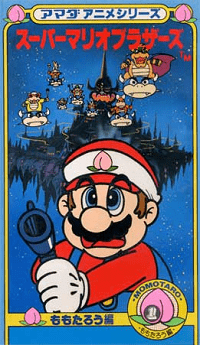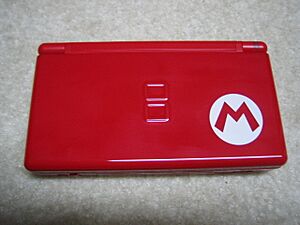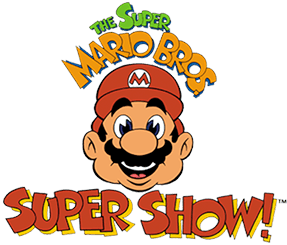List of non-video game media featuring Mario facts for kids
The world of Mario isn't just about video games! Mario and his friends have also appeared in many other types of media. This includes TV shows, animated movies, live-action films, comic books, toys, and even music.
Contents
- Mario on TV: Animated Shows and Specials
- Early Adventures: Saturday Supercade
- First American Series: The Super Mario Bros. Super Show!
- King Koopa's Own Show: King Koopa's Kool Kartoons
- More Adventures: The Adventures of Super Mario Bros. 3
- Game Show Fun: The Super Mario Challenge
- Dinosaur Land Adventures: Super Mario World
- Ice Skating Fun: Mario Ice Capades
- Mario on the Big Screen: Films
- Mario in Anime: Japanese Animated Videos
- Mario in Print: Comics and Manga
- Mario Merchandise: Toys and More
- Mario Events: Special Celebrations
- Mario in Real Life: Theme Parks
- Mario's Music
- See also
Mario on TV: Animated Shows and Specials
Mario and his friends have starred in several animated TV shows and special programs.
Early Adventures: Saturday Supercade
Saturday Supercade was an animated TV show that started in 1983. It featured popular video game characters from the early days of arcade games. Donkey Kong, Mario, and Pauline from the Donkey Kong arcade game were all part of this show.
First American Series: The Super Mario Bros. Super Show!
The Super Mario Bros. Super Show! was the first American TV series based on the Mario games for the NES. It aired from September to December 1989. The show was inspired by Super Mario Bros. and Super Mario Bros. 2.
King Koopa's Own Show: King Koopa's Kool Kartoons
King Koopa's Kool Kartoons was a live-action children's TV show from 1989. It starred King Koopa, who is the main bad guy in the Mario series. This show was broadcast in Southern California.
More Adventures: The Adventures of Super Mario Bros. 3
The Adventures of Super Mario Bros. 3 was the second TV series based on the Mario NES games. It aired in 1990 and was based on the Super Mario Bros. 3 video game. In this cartoon, Mario, Luigi, Princess Toadstool (now known as Princess Peach), and Toad fought against Bowser and his Koopalings.
Game Show Fun: The Super Mario Challenge
The Super Mario Challenge was a game show that aired from 1990 to 1991. The host, John Lenahan, looked just like Mario and wore his clothes! Two players would compete in challenges using Mario video games like Super Mario Bros., Super Mario Bros. 2, and Super Mario Bros. 3. They would race to finish levels or collect the most coins.
Dinosaur Land Adventures: Super Mario World
Super Mario World is an animated TV series based on the SNES video game. It was the third and last Saturday morning cartoon based on the Mario series, airing in 1991.
Ice Skating Fun: Mario Ice Capades
Mario Ice Capades was a TV special from 1989. It featured a Mario-themed ice skating show.
Mario on the Big Screen: Films
Mario and his world have also appeared in movies!
First Animated Film: Super Mario Bros.: The Great Mission to Rescue Princess Peach! (1986)
Super Mario Bros.: The Great Mission to Rescue Princess Peach! is an anime film from 1986. It was based on the Super Mario Bros. video game. The story follows Mario and Luigi as they try to save Princess Peach from Bowser. This movie is special because it was the first film ever based on a video game!
Live-Action Adventure: Super Mario Bros. (1993)
Super Mario Bros. was a live-action movie released in 1993. It was a science-fiction comedy adventure film based on the Super Mario Bros. video game series. The movie starred Bob Hoskins as Mario and John Leguizamo as Luigi. The story was about the Mario brothers finding a parallel universe ruled by the evil King Koopa (Bowser). He wanted to combine the two worlds. Mario and Luigi had to team up with Princess Daisy to stop him.
While the movie wasn't very popular when it first came out, some people now see it as a cult film.
New Animated Hit: The Super Mario Bros. Movie (2023)
The Super Mario Bros. Movie is an animated film from 2023. It was made by Illumination and Nintendo. The movie features the voices of famous actors like Chris Pratt as Mario, Anya Taylor-Joy as Peach, Charlie Day as Luigi, and Jack Black as Bowser.
The film tells an origin story about Mario and Luigi, who are plumbers from Brooklyn. They get transported to a magical world and become part of a big battle. This battle is between the Mushroom Kingdom, led by Princess Peach, and the Koopas, led by Bowser.
The movie was a huge success around the world. It broke many box office records, becoming one of the highest-grossing animated films ever!
Mario in Anime: Japanese Animated Videos
Mario has also appeared in special animated videos released in Japan.
Fairy Tale Fun: Amada Anime Series: Super Mario Bros.
| Amada Anime Series: Super Mario Bros. | |
 |
|
Quick facts for kids アマダアニメシリーズ スーパーマリオブラザーズ(Amada Anime Shirīzu Sūpā Mario Burazāzu) |
|
|---|---|
| Genre | Adventure, comedy |
| Original video animation | |
| Produced by | Shinichiro Ueda |
| Written by | Juri Yagi |
| Studio | Studio Junio |
| Released | August 3, 1989 |
| Runtime | 15 minutes each |
| Episodes | 3 |
Amada Anime Series: Super Mario Bros. is a series of three direct-to-video animated movies released in Japan in 1989. These videos tell classic Japanese fairy tales using characters from the Mario world. The stories include Momotarō, Issun-bōshi, and Snow White.
Learning with Mario: Mario Kirby Masterpiece Video
Mario Kirby Masterpiece Video is an 18-minute educational video from 1995. It was released in Japan to help children learn kanji (Japanese characters). It features separate adventures with Mario and Kirby.
Safety First: Super Mario's Fire Brigade and Super Mario Traffic Safety
Super Mario's Fire Brigade is a short video from 1989 that teaches about fire safety. There was also another video called Super Mario Traffic Safety that taught about staying safe on the roads.
Interactive Adventures: Super Mario World: Mario & Yoshi's Adventure Land
Super Mario World: Mario & Yoshi's Adventure Land is an interactive anime video from 1991. It was based on Super Mario World. Viewers could answer questions using a special telephone-shaped microphone. For example, they could guess what would hatch from Yoshi's egg!
Mario in Print: Comics and Manga
Mario's adventures have also been told in comic books and Japanese manga.
Long-Running Manga: Super Mario-kun
| Super Mario-kun | |
| スーパーマリオくん (Sūpā Mario-kun) |
|
|---|---|
| Genre | Adventure, comedy |
| Manga | |
| Written by | Yukio Sawada |
| Published by | Shogakukan |
| English publisher | |
| Demographic | Kodomo |
| Magazine | CoroCoro Comic |
| Original run | November 1990 – ongoing |
| Volumes | 56 |
Super Mario-kun is a very popular Japanese manga series. It started in 1990 and is still going strong, with over 50 volumes! It follows Mario and his friends through the stories of many Mario video games, from Super Mario World all the way to Super Mario Odyssey.
Nintendo Comics System
The Nintendo Comics System was a series of comic books published in 1990 and 1991. It featured characters from Nintendo's video games and the cartoons based on them.
Super Mario Adventures
Super Mario Adventures was a collection of comics that appeared in Nintendo Power magazine in 1992. These comics featured characters from the Mario series and were loosely based on Super Mario World. The story followed Mario and Luigi as they tried to rescue Princess Peach after she was kidnapped by Bowser.
Choose Your Own Adventure: Gamebooks
Nintendo Gamebooks were special gamebooks where you could choose what happened next in the story. They were based on video games created by Nintendo.
Mario Merchandise: Toys and More

Mario has appeared on all sorts of merchandise! You can find him on lunch boxes, T-shirts, magazines, and even shampoo bottles. There are also many plush toys of Mario and his friends. Companies have also made Mario-themed versions of popular board games like Monopoly and Connect 4.
Mario Events: Special Celebrations
There are special events and celebrations dedicated to the world of Mario!
National Mario Day
National Mario Day is an annual holiday celebrated on March 10. This date is chosen because "MAR 10" looks like the name MARIO! Gamers celebrate by playing Mario games or attending Mario-themed events. They also share their fun on social media using the hashtag #NationalMarioDay.
The Year of Luigi
In March 2013, Nintendo started the Year of Luigi. This was a special year dedicated to Mario's brother, Luigi! It included new Luigi-themed games like Dr. Luigi and New Super Luigi U. The Year of Luigi ended in March 2014.
Super Mario Bros. 35th Anniversary
In September 2020, Nintendo began the Super Mario Bros. 35th Anniversary event. This celebration lasted until March 2021. It started with a special announcement that revealed many new games and merchandise related to Mario.
Mario in Real Life: Theme Parks
Super Nintendo World
Super Nintendo World is an amazing themed area inside Universal Studios Japan and Universal Studios Hollywood. It's also being built for Universal Epic Universe and planned for Universal Studios Singapore. These areas are designed to look just like the worlds from the Super Mario games, as well as Yoshi's Island and Donkey Kong Country.
Mario's Music
The Super Mario video games are famous for their catchy music, much of it created by Koji Kondo. The "Super Mario Bros. theme" is especially well-known around the world. This famous theme has been played in many concerts, including "PLAY! Chicago" and "Video Games Live."
See also
- List of unofficial Mario media


